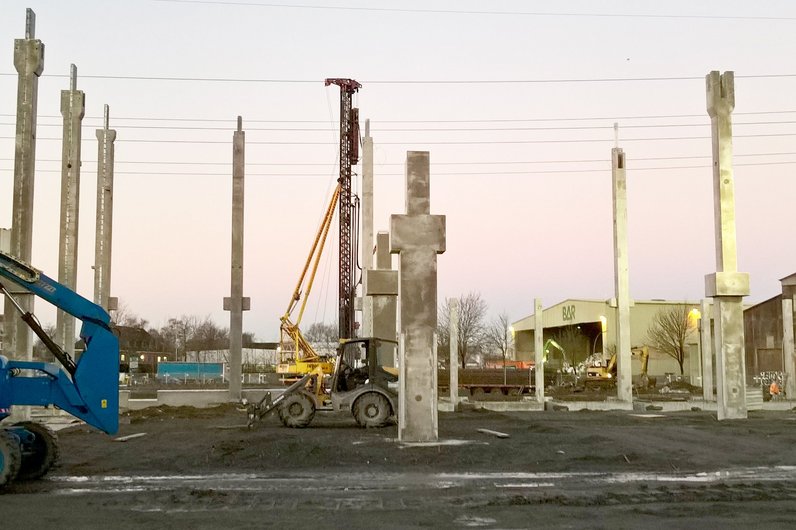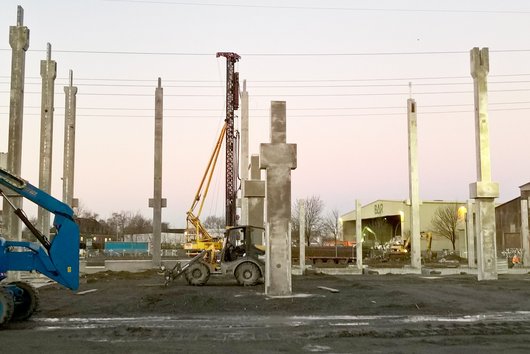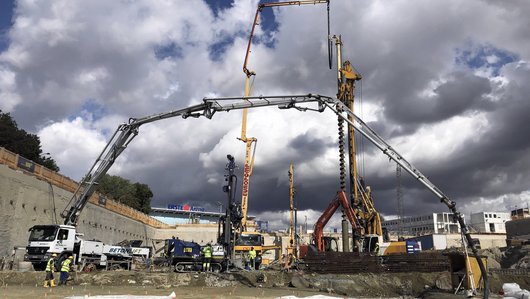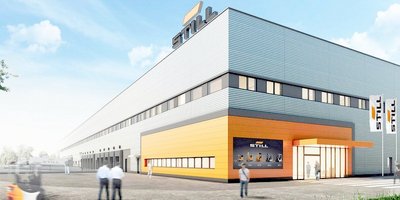
founded and awarded
Pile foundations for the STILL logistics centre
PORR carried out extensive pile foundation work for STILL GmbH's new Hamburg logistics centre, working on a contaminated construction site.
The completed project won the “Logix Award 2017” at real estate trade fair Expo Real in Munich. The jury were impressed with the logistics centre’s functionality, efficiency and sustainability.
-
EmployerMax Bögl Stiftung & Co. KG
-
ContractorPORR Spezialtiefbau GmbH
-
Project typeSpecialist civil engineering, Foundation construction
-
Project scopePile foundation
-
Order volumeEUR 1.8 million
-
Construction start08/2016
-
Construction end12/2016
General
STILL GmbH's new logistics centre in Hamburg-Billbrook comprises two warehouse complexes with a total surface area of around 27,000m². ECE Projektmanagement GmbH & Co. KG undertook the development, planning and realisation of this major project, which involved a total investment volume of EUR 30 million. The facility was developed on a 43,000m² plot, which had to be completely sealed for the purpose. The pile foundation contract for over 2,800 simplex piles was awarded to PORR special civil engineering in July 2016.
Award-winning work
The completed project, which was sold to Deka Immobilien GmbH at the end of 2016 – while construction was still ongoing – received two particularly prestigious awards from the logistics and real estate sector. First, the building's high social, ecological and economic standards were recognised with a Gold Certificate from the German Sustainable Building Council (Deutschen Gesellschaft für Nachhaltiges Bauen: DGNB). Then on 4 October 2017, the building won the “Logix Award 2017” at real estate trade fair Expo Real in Munich. This prize was established in 2013, and is awarded every other year (by an independent jury) for “excellent logistic real estate developments”. The jury commended the brownfield development as a “model example of the renovation of a contaminated former industrial site” and emphasised “the solution-oriented collaboration between environmental and economic authorities, project developers, users and landowners”.
![[Translate to English:] Logistikzentrum STILL. Pfahlbaugruendung The new STILL logistics centre in Hamburg has a foundation consisting of around 2,800 FRANKI simplex piles.](/fileadmin/_processed_/3/8/csm_Bild_1_Pfahlgruendung_fuer_STILL_Logistikzentrum_d6d12c8980.jpg)
![[Translate to English:] Logistikzentrum STILL. Pfahlbaugruendung The new STILL logistics centre in Hamburg has a foundation consisting of around 2,800 FRANKI simplex piles.](/fileadmin/_processed_/3/8/csm_Bild_1_Pfahlgruendung_fuer_STILL_Logistikzentrum_d6d12c8980.jpg)
You can rely on FRANKI. Despite the onset of winter and cramped conditions, we were able to keep our appointment.
The project
The building site has 4 landfills up to 6m deep and around 3 to 7m of clay; only below this is the load-bearing sand layer reached. Above the impermeable clay and lime layer, standing groundwater becomes stagnant; below the clay layer, PORRians encountered pressurized groundwater. As they drilled, this highly-pressurized water sprayed out in fountains.
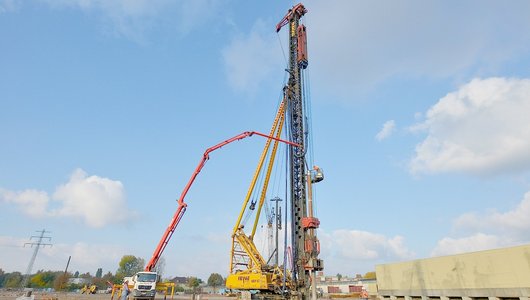

Due to the non-homogeneous nature of the infill, with its correspondingly varying load-bearing capacity, plus the non-load-bearing clay below the infill, the building supports had to be given deep foundations in the load-bearing Pleistocene sand and gravel layer. These supports, which are sensitive to settlement, have the purpose of preventing unacceptable settlement and settlement variations. It was therefore necessary to create a deep foundation on simplex piles – the contaminated landfill and thick clay would have made a surface foundation economically unfeasible.
Simplex piles, also known as base-plate piles, are cost-efficient driven cast-in-situ concrete piles. They are commonly used in foundation projects where large numbers of piles are required, as they have a short production time. A large ram is used for manufacture. A thick-walled shell (ramming pipe) is sealed off at the base (watertight), using a base plate. Once the desired depth has been reached, a reinforcement cage is installed, the concrete is filled in and the shell is retracted.
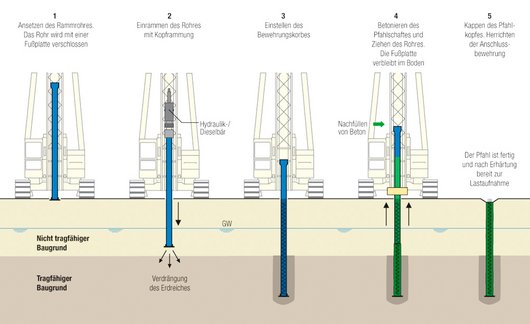

Deep foundations on contaminated ground
The new STILL logistics centre was constructed on a potentially contaminated legacy area: from the middle of the 19th century until the 1960s, the Billwarder chemical factory manufactured carbon disulphide, calcium cyanamide, saltpetre and Glauber's salt on the site. This means there is a risk that parts of the ground are contaminated. The simplex piles once again have the advantage here: thanks to complete soil displacement, no soil material is removed. With the usual type of drilled piles, potentially-contaminated soil would have been removed and then would have had to be cost-intensively disposed of as hazardous waste.
In order to keep to the tight deadlines and work more effectively, two large pieces of special equipment were used, enabling FRANKI to manufacture an average of 50 piles a day. From October 2016, the foundation works ran in parallel with construction of the structural carcass. In order to carry out the work at the second complex, it was necessary to travel beneath a Vattenfall 110kVA power line running between the two complexes. To maintain a safe distance from this power line, the devices were dismantled on one side and reassembled on the other. Between August and the beginning of December 2016, FRANKI installed more than 2,800 piles in this way, ranging in length from 11m to 22m.
![[Translate to English:] Logistikzentrum STILL Pfahlbaugruendung Exposed pile head with blinding layer.](/fileadmin/_processed_/f/3/csm_Bild_5_Pfahlgruendung_fuer_STILL_Logistikzentrum_893e7ee225.jpg)
![[Translate to English:] Logistikzentrum STILL Pfahlbaugruendung Exposed pile head with blinding layer.](/fileadmin/_processed_/f/3/csm_Bild_5_Pfahlgruendung_fuer_STILL_Logistikzentrum_893e7ee225.jpg)
Technical data
-
Bay widths12x12m und 12x24m
-
Simplex piles2.821
-
Integrity tests150
-
Surface load: Storage surface50kN/m²
-
Surface load: palette rack stores60kN/m²
-
Surface load: per rack72kN
-
Execution planningIngenieurservice Grundbau GmbH (isg)
-
Pile foundationPORR Spezialtiefbau GmbH
Summary
The large number of piles was manufactured on deadline using two large pieces of equipment. Great care was necessary near the high-voltage power line crossing the site. Despite the onset of winter near the end of the construction period, not to mention space restrictions due to the parallel work ongoing on the structural carcass, PORR was able to complete their task on schedule. The cherry on the top: PORR was able to celebrate the project’s awards with the project partners and client.

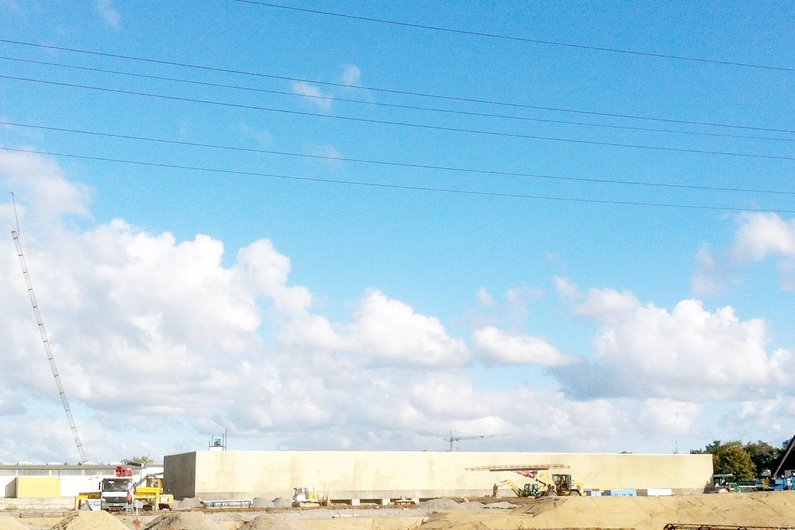
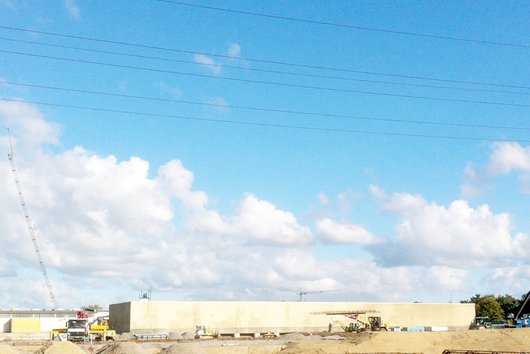
![[Translate to English:] Logistikzentrum STILL Pfahlbaugruendung Exposed pile head with blinding layer.](/fileadmin/_processed_/f/3/csm_Bild_5_Pfahlgruendung_fuer_STILL_Logistikzentrum_6771af1f05.jpg)
![[Translate to English:] Logistikzentrum STILL Pfahlbaugruendung Exposed pile head with blinding layer.](/fileadmin/_processed_/f/3/csm_Bild_5_Pfahlgruendung_fuer_STILL_Logistikzentrum_cf664eff7d.jpg)
